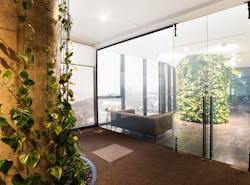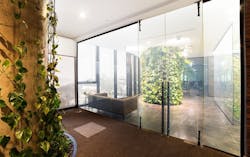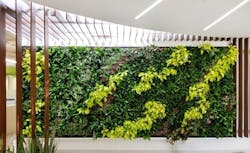Biophilia — the theory, science and practice of creating buildings and products inspired by and incorporating nature — has been studied since it was first popularized by Edward O. Wilson in 1984. Since then, research has increased in better understanding the impact that nature has on the psychological and physical health and wellness of humans, particularly in office interiors.
Biophilic design includes but isn’t limited to:
- Access to natural light
- Products which are made of or look like natural materials
- The inclusion of living plants into the space
- Lighting which mimics natural daylight
Human Spaces: The Global Impact of Biophilic Design in the Workplace, surveyed 7,600 respondents from 16 countries around the world to quantify the ways in which biophilia affects employees.
Initial Findings
What this Means for Building Owners and Facility Management
Due to technology, most employees don’t need to be present daily in an office, with many able to work full-time outside of a shared office.
For building owners and facility managemers who need to rent out their building’s space, any additional means of enticing employees to use office space can increase leasee retention and entice new occupants.
Keeping biophilia in mind when approaching the design and layout of a building can not only increase the employees’ sense of well-being, but work toward increasing the attractiveness of the property to potential and current companies.
Studies, including the Human Spaces: The Global Impact of Biophilic Design in the Workplace, have shown that increasing the psychological and physical well-being of employees leads to increased productivity and performance, attendance (fewer sick days are reported), retention, attractiveness to recruits and user satisfaction.
Particularly as companies become increasingly owned and operated by those in the millennial population (those born between 1980 and 1995) and Generation Z (those born between 1996 and 2010), health and well-being will become more common and necessary elements of the workplace.
Both millennials and Generation Z are more understanding of their physical and mental needs, and mental health is less stigmatized by those populations. These generations will be drawn toward spaces that make them feel better, more productive and provide amenities that align with current research.
[10 Amenities to Improve Well-being at Your Property]
How to Increase Biophilic and Wellness-Centered Elements
Although it would be great if each office space could be a natural oasis of light and greenery, it’s not always possible.
The first thing that building owners and facility managers can take away from the report is that, while the trend seems to show open offices will continue to prevail, there’s a need for spaces where employees can get away and do quiet, heads-down work.
Including plants and water features in office interiors also has a profound affect on employees. Living walls are becoming easier to manage and install. However, if a permanent addition to the building isn’t in the cards, bringing in potted plants or including a water sculpture in the entryway or in the offices will stimulate the positive portion of the brain.
Nothing says dedication to green building like putting actual greens in a building...
Color and biophilic products and elements are also an easy way to bring health and wellness to the interior. As the study stated, natural colors such as green, blue and brown decreased employee stress, while gray increased it.
Using calming blue or green paint on the walls in quiet or social areas, utilizing natural-themed wallcoverings in the same spaces, or including blue and green accents in the office, such as the upholstery for furniture, can do the trick.
Advancements in technology have also meant that durable materials such as luxury vinyl tile, ceramic and porcelain tiles, counter surfacing products and carpets/rugs are able to be designed to look identical to their natural counterparts. High-definition scanning and printing means wood and stone can be uploaded and printed directly to high-traffic products without the need for upkeep.
Incorporating artificial light that gives off a natural glow is another easy element to update.
Natural-appearing lighting is everywhere these days, so there isn’t a need to special order bulbs or change lighting fixtures. And with increased Internet of Things capabilities leading to lower prices for high-performing technology, natural lighting output has never been easier.
About the Author

Kadie Yale
Former Architecture & Design Expert
Kadie Yale holds a BA in Industrial Design from San Francisco State University and MA in Decorative Art History and Theory from Parsons the New School.



